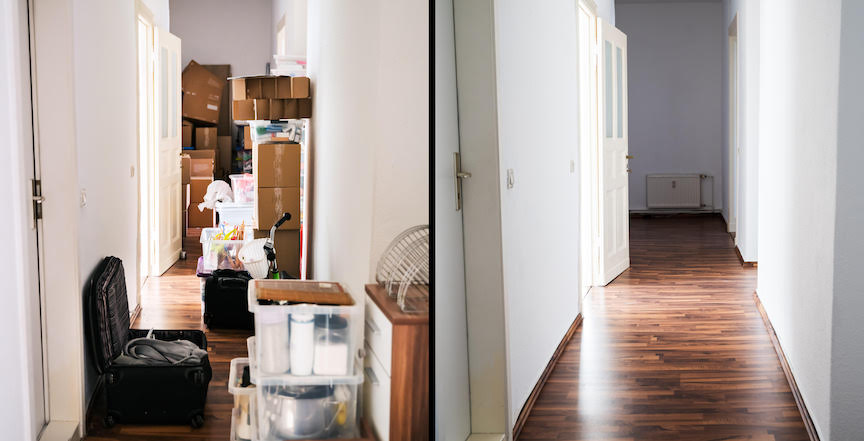
Judd Matsunaga
When you’ve lived in the same home for decades, things tend to accumulate. Eventually, you can find yourself surrounded by things you have no intention of using again. It’s bad enough when your basement is full of junk, but when the clutter spreads into your bedroom, living room, den and hallways, it can block your way and become a tripping hazard.
To age in place safely, remove clutter or any tripping hazards on the floor. Piles of papers, clothes and books and electrical cords that snake through hallways can trip you up if you don’t watch where you’re going. Move furniture out of the way to give yourself wide access to every room.
The more stuff you have, the more intimidating — and time consuming — it is to clear away. To make the decluttering project more manageable, don’t try to tackle everything at once.

To age in place safely, remove clutter or any tripping hazards on the floor.
Set aside a couple of hours, and work through one section at a time. Start by making three piles: 1. keep, 2. throw out, 3. sell or donate. Give careful thought to the things you’re considering keeping. Ask yourself, “Have I used this in the last two years?” “Will I use it in the next two years?” “Does it work?” “Does it have so much sentimental value that I can’t bear to part with it?” If the answer to these questions is “no,” get rid of it.
At the end of the two hours, put away everything in your “keep” pile, toss the “throw out” pile in the trash and take the “sell or donate” pile to your local consignment shop, Goodwill store or swap meet. Some nonprofit organizations, including Big Brothers Big Sisters and Habitat for Humanity, will pick up items from your home to make the process easier.
If you do have an emotional connection to an item but don’t have room, think about giving it to your child, donating it to a local museum or taking a picture of it to preserve your memory of it. If you’re struggling to part with anything, consider getting a professional organizer. And if you think you might have a compulsive hoarding problem, ask your primary care provider to recommend a mental health professional who can help.
In addition to removing clutter to prevent falls, a special health report from Harvard Medical School, “Aging in Place,” says that rather than live in fear of falling, seniors should try the following strategies:
- Do a home safety inventory. Start by doing a home safety walk-through. Make needed changes to your house, such as adding lighting to stairways and installing grab bars and nonskid surfaces in bathrooms.
- Practice balance exercises. Exercise is good for preventing falls, but balance exercises specifically strengthen the muscles that support you and keep you upright. Every day, set aside a few minutes to practice balance exercises.
- Get your vision checked. Without clear vision, you can overlook obstacles in your way and be unable to discern dimensions. Your eyes naturally lose some of their focusing power as you age, and presbyopia — the loss of close vision — becomes more common. See your ophthalmologist for a complete eye exam once every year or two. Update your glasses as needed.
- Try tai chi. Better balance translates into fewer falls. Tai chi has been shown to be very effective for improving balance, strength and muscle control and making you more aware of your body’s position in relationship to your surroundings.
- Review your medications. Several different drug classes, from pain relievers to antidepressants, can increase your risk for a fall. Each year, review the medicines you take with your doctor and pharmacist. Look for any medications that could make you unsteady on your feet.
- Check your vitamin D status. The U.S. Preventive Services Task Force recommends vitamin D (along with calcium) for preventing fractures in people who are deficient in this vitamin. A quick blood test from your doctor can determine whether you’re low on vitamin D and need a supplement.
- Wear the right shoes. To prevent falls, wear shoes that fit your foot snugly and have a low heel and a nonskid sole. Walking barefoot or in socks can have risks, too.
- Treat chronic pain. It’s important to see your doctor or a pain specialist to address and control your pain. Constant aches and pains can disrupt your life in many ways, one of them being an increased risk for falls.
- Treat health issues. A number of health issues that become more common with age contribute to the risk for falls. Alzheimer’s and other types of dementia can rob you of the judgment you need to navigate your surroundings. See your doctor to assess your risks for these conditions, and get treated.
- Avoid alcohol. Your body metabolizes alcohol differently now than it did when you were younger. Certain medicines can also intensify the effects of alcohol. Alcohol can throw off both your balance and judgment, making a fall more likely.
In conclusion, lighting can be used to reduce fall risks in older adults. Older eyes have more difficulty discerning objects with little contrast. Aging can also throw off your depth perception. Keep the light strength uniform from room to room. Install a dimmer switch by your front door, so you can turn on the light gradually as you enter the house at night. Increase illumination where you need it. Marking each stair with a white or brightly colored tape stripe will help you see it.
If you’re worried about disrupting sleep, a night-lighting system providing visual cues and low ambient illumination is a good idea. Seeing your ophthalmologist for regular vision checkups is also a good idea. Keeping your eyeglass or contact lens prescription up to date is one way to avoid falling.
Judd Matsunaga is the founding attorney of Elder Law Services of California, a law firm that specializes in Medi-Cal Planning, Estate Planning and Probate. He can be contacted at (310) 348-2995 or judd@elderlawcalifornia.com. The opinions expressed in this article are the author’s own and do not necessarily reflect the view of the Pacific Citizen or constitute legal or tax advice and should not be treated as such.



